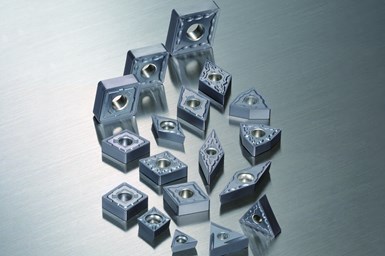New Coated Turning Grades From Sumitomo
Eastec 2021: The new grades feature heat-resistant, cemented carbide base material, which Sumitomo claims has excellent high-temperature hardness and strength.
Sumitomo showcases new coated turning grades for heat resistant alloys at Eastec, booth 5236. New to the AC5000S Series is the AC5005S for high-efficiency machining.
AC5005S features the newly developed heat-resistant, cemented carbide base material, which Sumitomo claims has excellent high-temperature hardness and strength for wear resistance and plastic deformation resistance during processing. The new grade reportedly has double the abrasion resistance compared to competitors. Rounding out the AC5000S series are the AC5015S for general purpose machining and the AC5025S for heavy, interrupted machining.
The AC5005S series incorporates physical vapor deposition coating technology, Absotech, as well as an AlTiSiN-based, multilayer thin film structure with heat resistance. This coating reportedly achieves crater wear resistance and flank wear resistance. The turning grade for exotics also have a tough carbide base material for maintaining hardness via a new sintering process. Sumitomo says the process improves toughness and has excellent boundary resistance, resulting in chipping resistance. Available chipbreakers for the AC5000S series include EEF for finishing, EEG for medium cutting and EEM for rough/interrupted cutting.
Related Content
-
Orthopedic Event Discusses Manufacturing Strategies
At the seminar, representatives from multiple companies discussed strategies for making orthopedic devices accurately and efficiently.
-
Selecting a Thread Mill That Matches Your Needs
Threading tools with the flexibility to thread a broad variety of holes provide the agility many shops need to stay competitive. They may be the only solution for many difficult materials.
-
The Impact of Cutting Teeth Spacing on Machining Stability
Many cutter designs are available, and variable teeth spacing (or variable pitch) cutters can be used to influence milling stability. Let’s discuss why teeth spacing affects stability.














